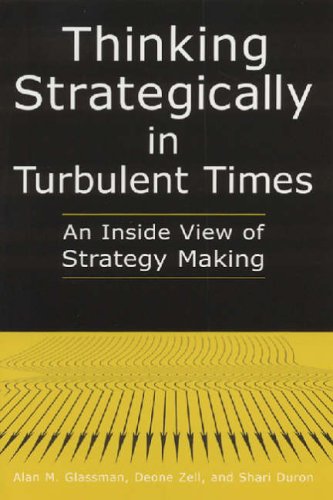

Most ebook files are in PDF format, so you can easily read them using various software such as Foxit Reader or directly on the Google Chrome browser.
Some ebook files are released by publishers in other formats such as .awz, .mobi, .epub, .fb2, etc. You may need to install specific software to read these formats on mobile/PC, such as Calibre.
Please read the tutorial at this link: https://ebookbell.com/faq
We offer FREE conversion to the popular formats you request; however, this may take some time. Therefore, right after payment, please email us, and we will try to provide the service as quickly as possible.
For some exceptional file formats or broken links (if any), please refrain from opening any disputes. Instead, email us first, and we will try to assist within a maximum of 6 hours.
EbookBell Team

4.8
94 reviews
ISBN 10: 0765612518
ISBN 13: 978-0765612519
Author: Alan Glassman, Deonne Zell, Shari Duron
An emergent approach to organizational strategy making assumptions that few organizations actually realize the goal of deliberative, top-down strategic planning, and that effective strategy making occurs on a continual basis and is a shared activity of the entire organization. This innovative book provides the first in-depth look at how real organizations are formulating and implementing strategic change under this new paradigm. The authors have dug deep into three large and varied organizations (Hewlett-Packard, the California State University system, and the County of Los Angeles) and identified each one's efforts to develop a new strategic planning process better-suited to match the current pace of change and environmental unpredictability. The book is filled with vignettes, quotes, and real-world examples that illustrate the trend toward faster, more adaptive strategic planning processes. It is relevant for a wide range of business, governmental, and non-profit settings, and should be required reading in any course on strategic planning.
1 Introduction: The Contextual Framework
Defining Turbulence
A Cross-Sector Phenomenon
The Strategic Process and Turbulence
The Leadership Connection
The Three Giants' Study
Methods
Sample
Data Collection and Analysis
Appendix A Detailed Methodology
Remaining Objective by Suspending Preexisting Biases and Beliefs
Theoretical Sampling of Subjects for the Development of Theory
Use of Coding Procedures to Build from the Concrete to the Abstract
Iterative Analysis of Data Using the Constant Comparative Method
Appendix B Interview Protocol
Background
The Environment
Strategy Process
Appendix C Codebook
2 Thinking Strategically at Hewlett-Packard
A Time of Transition
The Interview Sample
The Compaq Computer Overlay
External Environmental Forces
The Economy
Technology
The Role of Competition, Focus on Cost, and Commoditization
Customer Demand
Globalization and Connectedness
Corporate Scandals
The Pace of Change and Sense of Turbulence: Still Crazy After All These Years?
Adaptation to the Pace and Sense of Turbulence
Strategy at Hewlett-Packard
Evolution of H-P Strategy
Ten-Step Business Planning Process
Moving Away from the Ten-Step Approach
Reflections on Strategy Formulation: Interview Findings
Strategy Starting Point—The Market and Customers
Scenario Thinking Augments Strategy
Different Strategy Approaches Pre-Merger
Alignment
The Centralized Versus Decentralized Organization
Planning Cycle
Scanning the Environment
Conclusions
3 Thinking Strategically in Los Angeles County
The Interview Sample
Environmental Forces
Demographics
The Economy
Federal/State Rules and Regulations
Technology—Customer Demand
Homeland Security
Media
Board of Supervisors—Competing Departmental Needs
The Circle Game
Strategic Planning in Los Angeles County
Setting the Foundation for Strategic Planning (1994–1997)
If At First You Don't Succeed, You Get Another Chance (1997–2000)
Elaboration and Learning (2000–2002)
The Role of Leadership
Halos and Blemishes
4 Thinking Strategically at the California State University
History of the California State University
The Interview Sample
External Environmental Forces
Demographics
Growing Enrollments
Changing Ethnic Mix
Economy and Budget
Technology
Competition
Accountability
Housing Costs
The Pace of Change: Turbulence? What Turbulence?
History and Evolution of the Strategy Process
Impetus for Strategy Process
Formation of Cornerstones
The Cornerstones Report
Reflections on the Process of Developing Cornerstones
Implementation of Cornerstones
The Accountability Process
Reflections on the Process of Implementing Cornerstones
Strategy at the Campus Level
Awareness of Cornerstones
Impact of Cornerstones
Campus-Level Strategic Planning Activities
Themes and Issues at the Campus Level
The Participative Approach
The Charette Process
Ongoing, Multiphase, Multiyear
Waiting for the Right Time to Begin Strategic Planning
Tailoring the Strategic Planning Process to the President's Initiatives
The Role of Leadership
Implementation
5 When Sectors Collide
The Eye of the Beholder
The Economy Is Causing Anxiety in All Three Organizations
Technological Change Is Pressuring All Three Organizations
Customer Demand Confronts Both Hewlett-Packard and Los Angeles County
The Current Geopolitical Situation Creates Unexpected Uncertainty for Hewlett-Packard and Los Angeles County
Demographic Shifts Affect Los Angeles County and the California State University System
Public Accountability Pressures Increase for Both Los Angeles County and the California State University System
Competition Sizzles at Hewlett-Packard and Begins to Emerge at the California State University
An Absolutist Versus Relativist View of Turbulence
Closing Thoughts I
In the End, It Is a Balancing Act
A Note on Differences
Closing Thoughts II
Epilogue
Hewlett-Packard
Los Angeles County
California State University
Notes
References
About the Authors
Index
strategic thinking for turbulent times
strategy-making in turbulent times
strategy making in turbulent times hbr
thinking strategically
thinking strategically definition
Tags: Alan Glassman, Deonne Zell, Shari Duron, Thinking strategically, strategy making